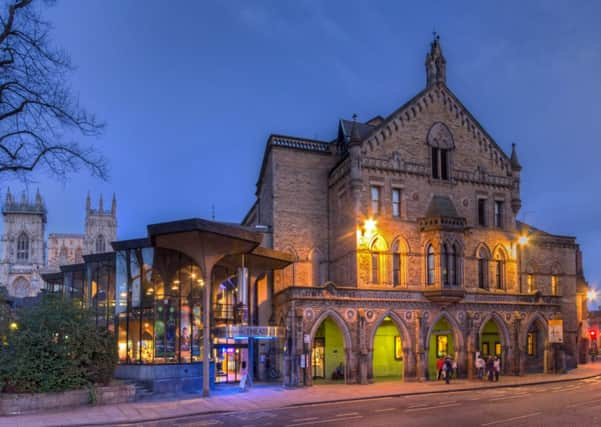Theatre looks to its past and an exciting future


With a number of our regional arts organisations affected by the funding cuts announced earlier this month, it was very pleasing to get some good news this week.
York Theatre Royal has heard that it has been awarded £2.9 million towards its £4.1 million Redevelopment Project. The award from Arts Council England is the most significant investment in the theatre since the extension to the foyer area in 1967.
Advertisement
Hide AdAdvertisement
Hide AdThe theatre will close in March 2015 for eight months during which time the auditorium will be reconfigured and refurbished, the foyer space increased and the whole building made more accessible.
Gathered together in the theatre’s studio space for the official announcement on Monday lunchtime were members of the press, staff and Friends of the Theatre, as well as representatives from partner organisations. Presenting at the event were the theatre’s chief executive Liz Wilson and artistic director Damian Cruden and they were joined by architect Angus Morrogh-Ryan and the director of the National Railway Museum Paul Kirkman – whose presence will shortly become clear.
There was a real buzz in the room and a genuine excitement emanating from all four as they described the future for the theatre both in the medium and long term. A theatre has operated on the site in York city centre since 1744 so while forward-looking, this is an organisation which is also very mindful of its past. And this sensitivity to the rich heritage of the building was apparent in what architect Angus Morrogh-Ryan, who is leading the renovation, had to say.
“With a project like this, in order to prepare for your future you need to understand your past. We wanted to reveal the layers of the building. The theatre building has changed incrementally over time and we are making sure that the next step will be consistent with its history.”
Advertisement
Hide AdAdvertisement
Hide AdThat history includes, within the theatre walls, the remains of a 12th century hospital and the entrance to the 15th century mint as well as evidence of a Roman well underneath the stage. The Georgians built on top of the medieval hospital foundations, the Victorians altered the façade to the Gothic style fashionable at the time, while the Edwardians increased the seating capacity of the auditorium.
So, the current plans are part of a long tradition.
“The theatre has survived because our story has been one of change and adaptation,” says Wilson. “We are immensely proud of the fact that York Theatre Royal is the oldest continuously working theatre in the country outside of London, but more so because what we have here is not a museum; it is still a thriving venue, hugely loved by the people of York and the surrounding area and integral to the healthy cultural life of this city.”
The improvements are part of a master plan to be rolled out over the next 10 to 15 years, so why choose now to begin phase one? It seems that the team at the theatre knew which way the wind was blowing in terms of funding. “We could see there was going to be a shift in the way that money would be made available,” says Cruden.
“And this might be the last round of capital investment that we would have the opportunity to bid for. And this is a plan not just for us but for the whole community – the audience in York deserves as good as anywhere in the country.” Improvements to the stage will also mean that Cruden will have the flexibility to programme shows which in design terms might once have been problematic to put on.
Advertisement
Hide AdAdvertisement
Hide AdWhile it is closed, the theatre will be revisiting its hugely successful partnership with the National Railway Museum for a revival of their award-winning production of The Railway Children to be staged in a temporary purpose-built space in the museum grounds. At the moment the plan is for the theatre to take up residence there for most of their closed period. “When Liz and Damian came to see me and asked me if we would be willing to host them on our site, we jumped at the chance,” says Kirkman. “It is a fantastic opportunity and we are really glad to be taking part in it. We are both in the business of telling stories and we can learn so much from each other.”
A thousand-seat theatre will be erected in the sidings of the South Yard which will also be the venue for a new community play, with the working title of Steam, that will involve the people of York as actors and allow audiences to explore the museum’s on-site collections in an exciting and innovative way.
There are also plans to launch an international Shakespeare festival – there isn’t one in the UK at the moment, although there are several in Europe – in partnership with the University of York. It will take place next May and it is hoped that it will become a long-term annual event.
The theatre will then reopen in time for the 2015 panto, penned and starring, as ever, legendary dame Berwick Kaler.
Advertisement
Hide AdAdvertisement
Hide AdIn the meantime, there is an exciting new season to look forward to starting this September and running through to next March.
It includes a number of co-productions, made in York, which will then tour the country. In-house productions include revivals of two modern classics – Harold Pinter’s Betrayal and Arthur Miller’s A View From the Bridge, directed by Cruden, while among the visiting productions are Roy Williams’ new version of Antigone, directed by Marcus Romer for Pilot Theatre, Northern Broadsides’ revival of Oliver Goldsmith’s She Stoops to Conquer and Nicholas Wright’s stage adaptation of Pat Barker’s novel Regeneration.
• For tickets call the box office on 01904 623568 and for details of the new season visit yorktheatreroyal.co.uk